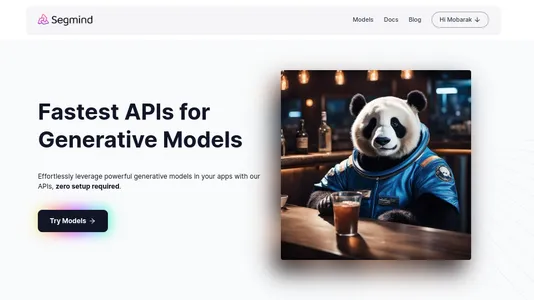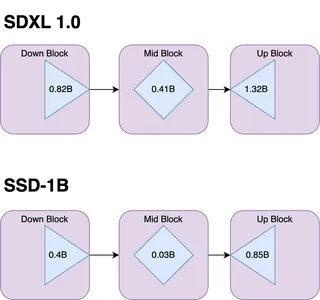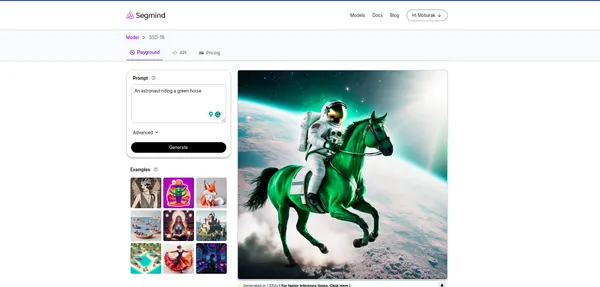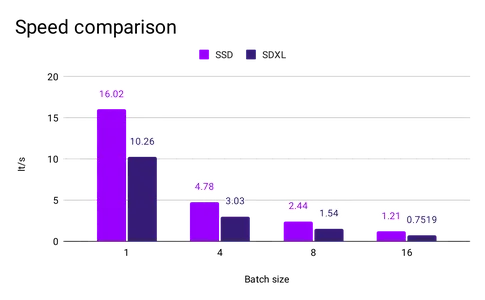Introduction
Segmind AI has proudly presented SSD-1B (Segmind Stable Diffusion 1B), a groundbreaking open-source text-to-image revolution of generative model. This lightning-fast model sets unprecedented speed, compact design, and high-quality visual outputs. Artificial intelligence has shown rapid strides in natural language processing and computer vision and has shown innovations that redefine the boundaries. The SSD 1B model is an open door to computer vision due to its key features. In this comprehensive article, we delve into the model’s features, use cases, architecture, training information, and more.

Learning Objectives
- To explore the architectural overview of SSD-1B and understand how it leverages knowledge distillation from expert models.
- Gain hands-on experience by trying out the SSD-1B model on the Segmind platform for lightning-fast inference and using code inference.
- Learn about downstream use cases and how the SSD-1B model can be used for specific tasks.
- To recognize the limitations of SSD-1B, especially in achieving absolute photorealism and maintaining text clarity in certain scenarios.
This article was published as a part of the Data Science Blogathon.
Table of contents
Model Description
A major challenge of using generative artificial intelligence has been the problem of size and speed. Handling text-based language models easily becomes a challenge of loading entire model weights and inference time, it becomes harder for images using stable diffusion. SSD-1B is a distilled 50% smaller version of SDXL with a 60% speedup while maintaining high-quality text-to-image generation capabilities. It is trained on diverse datasets including Grit and Midjourney scrape data, and excels at creating visual content based on words. This was achieved by the strategic distillation of knowledge from expert models (SDXL, ZavyChromaXL, and JuggernautXL). This distillation process, coupled with training on rich datasets, equips SSD-1B to handle a spectrum of commands.
Key Features of Segmind SD-1B
- Text-to-Image Generation: Excels at generating images from text prompts, enabling creative applications.
- Distilled for Speed: Designed for efficiency, a 60% speedup for practical use in real-time applications.
- Diverse Training Data: Trained on different datasets, making it effective for handling a variety of text.
- Knowledge Distillation: Combines strengths from multiple models for improved performance.
Model Architecture and Training Details
SSD-1B is a 1.3 billion parameter model that distinguishes itself by removing several layers from the SDXL model, optimizing its architecture for efficient text-to-image generation. Key hyperparameters used for training include 251,000 steps, a learning rate of 1e-5, a batch size of 32, an image resolution of 1024, and the implementation of mixed precision with fp16. The model’s adaptability shines as it supports different output resolutions, ranging from 1024×1024 to more unconventional sizes like 1152×896 and 896×1152.

In a notable speed comparison, SSD-1B achieves speeds up to 60% faster than the foundational SDXL model, a performance benchmark observed on A100 80GB and RTX 4090 GPUs. This architectural finesse and optimized training parameters position SSD-1B as a cutting-edge model in text-to-image generation.
Python Code Demo with Segmind SD-1B
To use the SSD-1B model, you can follow these steps. First, make sure to install the necessary libraries. you can find the entire notebook here: https://github.com/inuwamobarak/segmindSD-1B
1: Install Diffusers
# Install diffusers from source:
!pip install git+https://github.com/huggingface/diffusers
# Additionally, install transformers, safetensors, and accelerate:
!pip install transformers accelerate safetensors2: Import the necessary modules and initialize the model
from diffusers import StableDiffusionXLPipeline
import torch
# Initialize the pipeline using the pre-trained SSD-1B model:
pipe = StableDiffusionXLPipeline.from_pretrained("segmind/SSD-1B", torch_dtype=torch.float16, use_safetensors=True, variant="fp16")
# Set the device to use (set to "cuda" for GPU acceleration):
pipe.to("cuda")3: Define your prompts
# You can change these to generate different images:
prompt = "An astronaut riding a green horse"
neg_prompt = "ugly, blurry, poor quality"4: Generate an image based on the provided prompts
image = pipe(prompt=prompt, negative_prompt=neg_prompt).images[0]
# You can now use the 'image' variable to work with the generated image.5: View Image
image
Playground Demo with Segmind SD-1B
Go to https://www.segmind.com/ to create an account then go to https://www.segmind.com/models/ssd-1b or select the ‘Models’ tab to see the SSD-1B on Segmind website. Select playground and use the same prompt we used above in the Python inference.

Application of Segmind SD-1B
- Art and Design: SSD-1B is a canvas for generating artwork, designs, and creative content, as a muse for artists and designers.
- Education: The model finds application in educational tools, facilitating the creation of visual content for teaching and learning purposes.
- Research: Researchers leverage SSD-1B to probe generative models, evaluate performance, and explore the frontiers of text-to-image generation.
- Safe Content Generation: Offering a secure way to generate content, SSD-1B reduces the risk of inappropriate or harmful outputs.
Downstream Possibilities
The SSD-1B model seamlessly integrates with the Diffusers library training scripts which is room for further fine-tuning. This helps users to tailor the model to specific tasks and applications.
Why Segmind SD-1B Model?
- Architectural Distinctions: With a model size of 1.3 billion parameters and strategically removing layers from the foundational SDXL model, SSD-1B achieves a balance between size and quality. This architectural refinement contributes to its efficiency and swift performance.
- Adaptive Resolutions: SSD-1B flexes its strength by supporting output resolutions, catering to diverse creative needs. From 1:1 dimensions to different horizontal and vertical configurations, the model adapts to the intricacies of each prompt.
- Compact Design: Despite its compact design, being half the size of SDXL, SSD-1B doesn’t compromise on visual quality. It is a testament to optimization, delivering high-quality visual outputs. This means it doesn’t sacrifice quality for speed but decides to retain all the goodies.
- Knowledge Distillation: With insights from multiple models, SSD-1B undergoes a refinement process, improving its overall performance and pushing the boundaries of what’s achievable in text-to-image generation.
- Benchmarking Speed: The acceleration of SSD-1B becomes evident when comparing its speed to the SDXL model. With up to a 60% speed increase, the model exhibits efficiency across different GPU configurations, making it a practical choice for hardware setups.

- Diverse Training: The model’s training on different datasets underscores its strength in the generation of diverse visual content based on user prompts.
Possible Use Cases of Segmind SD-1B
- Artistic Expression and Design: In the realm of artistic creation, SSD-1B is a potent tool for generating artwork, designs, and other creative content. It becomes a source of inspiration, augmenting the creative process for artists and designers alike.
- Research Prowess: Researchers find SSD-1B a valuable asset for exploring generative models and evaluating their performance. The model’s capabilities invite researchers to delve deeper into the possibilities of AI-generated visuals, pushing the boundaries of what can be achieved.
- Safe Content Generation: The controlled nature of SSD-1B’s content generation capabilities addresses concerns about inappropriate or harmful outputs. It becomes a reliable resource for content creators and platforms seeking a secure means of generating visual content.
Licensing Insight: Apache 2.0
For those intrigued by the legal aspects, SSD-1B operates under the permissive Apache 2.0 license. This open-source license by the Apache Software Foundation allows users to freely modify, and distribute the software, even in proprietary projects. The inclusion of an express grant of patent rights and provisions for handling contributions adds another layer of transparency and collaboration. This is handy for business possibilities.
Accessing SSD-1B: A Gateway to Creativity
For researchers and developers wishing to explore the capabilities of SSD-1B, access is granted through the Segmind AI platform. This opens the doors to a myriad of possibilities, allowing innovators to experiment with the model and contribute to the evolution of AI-driven image generation.
Acknowledging Limitations and Bias
While SSD-1B excels in many aspects, it has challenges in absolute photorealism, especially in human depictions. Users are encouraged to understand its limitations, conscious engagement, and anticipation for its continued evolution. The model grapples with maintaining text clarity and fidelity in complex compositions due to its autoencoding approach. Users are encouraged to engage with SSD-1B consciously, understanding its current limitations and its continual evolution.
Conclusion
We have seen Segmind AI’s SSD-1B which is a groundbreaking open-source text-to-image generative model that sets unprecedented speed, compact design, and high-quality visual outputs. In conclusion, SSD-1B is a step of progress in text-to-image generation. Its speed, efficiency, and diverse capabilities make it an asset across domains. The open-source nature makes SSD-1B a tool for the masses, from researchers and artists to educators and creators. As AI continues to evolve, models like SSD-1B pave the way for the realization of stunning visuals from text commands.
Key Takeaways
- SSD-1B offers a remarkable 60% speedup, making it the fastest text-to-image model with unparalleled image generation times.
- Despite being 50% smaller than SDXL, SSD-1B maintains high-quality visual outputs, showcasing better design and efficiency.
- Leveraging insights from other models, SSD-1B refines performance through a robust distillation which improves text-to-image generation.
- SSD-1B operates under the Apache 2.0 license, allowing users to freely use, modify, and distribute the software. It is fine-tunable for specific tasks.
Frequently Asked Questions
A1: SSD-1B excels in text-to-image generation and can be applied in different domains, including art, design, education, research, and safe content generation.
A2: Train the model on different datasets, including Grit and Midjourney scrape data, ensuring it can effectively handle a range of textual prompts and generate diverse visual content.
A3: SSD-1B operates under the Apache 2.0 license, a permissive open-source license, allowing users to freely use, modify, and distribute the software, even in proprietary projects.
A4: Yes, you can fine-tune SSD-1B on specific tasks as it is open-source, giving users the ability to adapt the model to their unique requirements.
A5: While excelling in many aspects, SSD-1B faces challenges in achieving absolute photorealism, especially in human depictions. Encourage the users to be aware of these limitations for conscious engagement with the model.
Reference Links
- https://github.com/inuwamobarak/segmindSD-1B
- https://huggingface.co/segmind/SSD-1B
- https://www.segmind.com/models/ssd-1b
- https://www.segmind.com/ssd-1b
- https://www.segmind.com/
- https://github.com/huggingface/diffusers
The media shown in this article is not owned by Analytics Vidhya and is used at the Author’s discretion.
Related
- SEO Powered Content & PR Distribution. Get Amplified Today.
- PlatoData.Network Vertical Generative Ai. Empower Yourself. Access Here.
- PlatoAiStream. Web3 Intelligence. Knowledge Amplified. Access Here.
- PlatoESG. Carbon, CleanTech, Energy, Environment, Solar, Waste Management. Access Here.
- PlatoHealth. Biotech and Clinical Trials Intelligence. Access Here.
- Source: https://www.analyticsvidhya.com/blog/2023/11/text-to-image-revolution-segminds-sd-1b-model-emerges-as-the-fastest-in-the-game/



